The Chinese smartphone manufacturer, Vivo has come up with world’s first smartphone featuring a 24 MP selfie camera. Perfect selfies are a thing now and Vivo knows it. After Vivo V5 Plus, Vivo has added another selfie master that takes perfect selfies, selfies that look like it’s perfectly taken from DSLR cameras by adding bokeh effects. Vivo V7+ with 5.99-inch FullView display joins the league of selfie kings in a new look reducing the size of bezels. Here’s Vivo V7+ review.
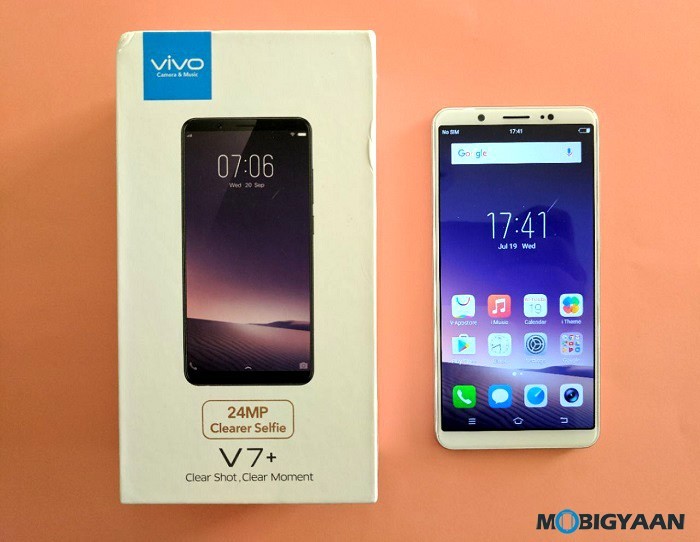
What’s in the Box
- Vivo V7+ with built-in battery
- Micro USB Cable
- Charger (5V, 2A)
- Silicon Clear Case
- SIM Tray Ejector
- User Guides and Warranty Card
Vivo V7+ Specifications
- Display: 5.99-inch FullView IPS Display, HD+ Resolution (1440 x 720 pixels), 2.5D curved Gorilla Glass 3
- Fingerprint Scanner: Yes, on the back
- Software: Android 7.1.2 Nougat, FunTouch OS 3.2
- CPU: Up to 1.8 GHz octa-core Cortex-A53 processor, Qualcomm Snapdragon 450, 14nm LPP
- GPU: Adreno 506, OpenGL 3.1+
- Memory: 4 GB LPDDR3 RAM
- Storage: 64 GB internal storage, MicroSD support up to 256 GB (dedicated slot)
- Main Camera: 16 MP f/2.0, PDAF, single LED flash, 1080p video @30fps
- Front Camera: 24 MP, f/2.0, Moonlight LED flash, Portrait Mode, Beauty Mode, HDR, 1080p video @30fps
- Connectivity: Micro USB port, USB OTG support, 3.5 mm stereo jack, Wi-Fi 802.11, Bluetooth 4.2, GPS, FM Radio
- Cellular: 4G LTE, Dual nano SIM (GSM), VoLTE-enabled
- Battery: 3,225 mAh Li-Ion (non-removable), Qualcomm QuickCharge 3.0
- Colors: Matte Black, Champagne Gold
- Price: ₹21,990
Design, Build & Ergonomics
Here’s the main highlight of the phone, the 24 MP camera with Moonlight Glow LED flash. It clearly states the selfie camera should be the best in class since it holds the bigger number. And we were expecting dual cameras, but hey, if a single camera can do the job of dual cameras, who needs it anyway?
Vivo V7+ flaunts a 5.99-inch FullView bezel-less display with HD+ resolution (1440 x 720 pixels). The display is protected by Corning Gorilla Glass 3 with a 2.5D curve. Holding the phone is quite comfortable, grippy, the edges are rounded, the weight feels a tad bulkier. There are two color variants – Matte Black, and Champagne Gold.
It is worth mentioning that Vivo V7+ looks premium, but the feel isn’t that great, yes it’s plastic. Vivo V7+ lacks a metallic design here, Vivo V5s too had the similar issue, plastics all around. In addition to that, the screen is HD+, not employing a full HD panel so the content may not be crisp on its large 6-inch display, no wonder the FullView screen looks amazing.
Wait, no physical touch keys? The touch navigation buttons are tucked under the screen and the external touch keys are removed, the home button is removed as well to gain space. For the fingerprint scanner, it is moved to the back alongside the camera. What’s there on the software front? Vivo V7+ comes with Android 7.1.2 Nougat and Funtouch OS 3.2 user interface.
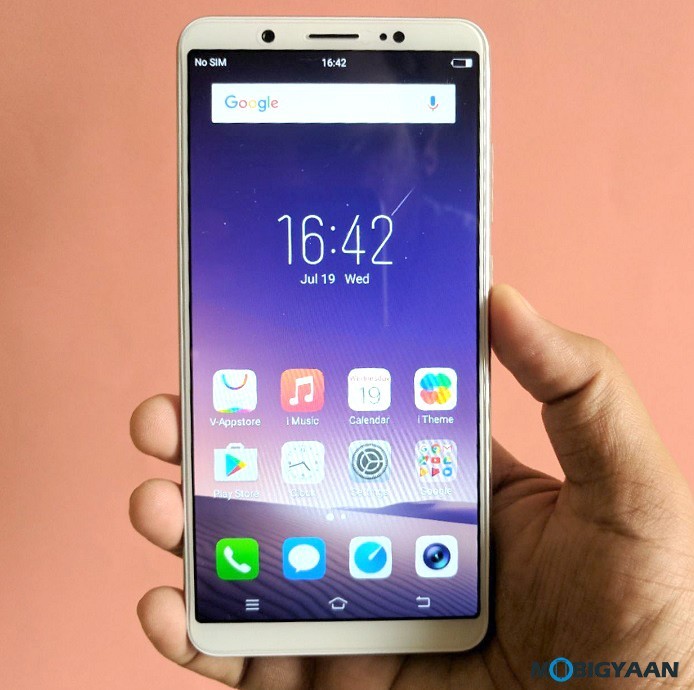
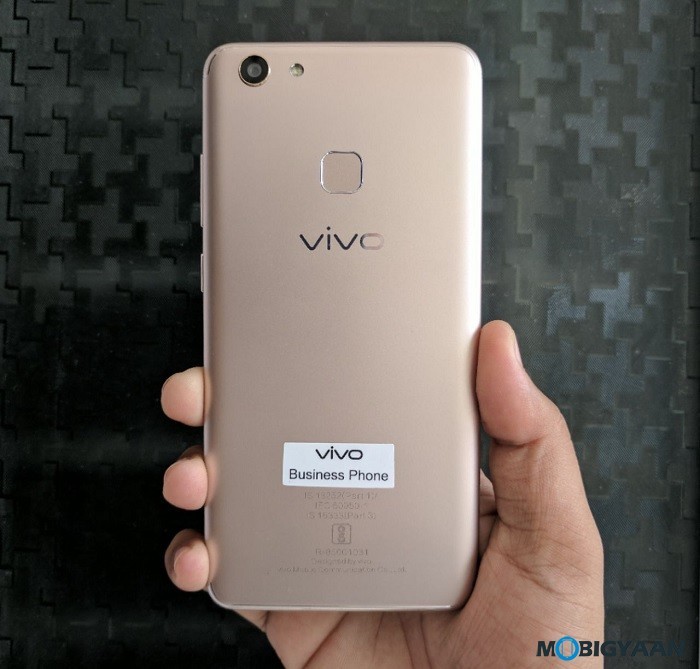
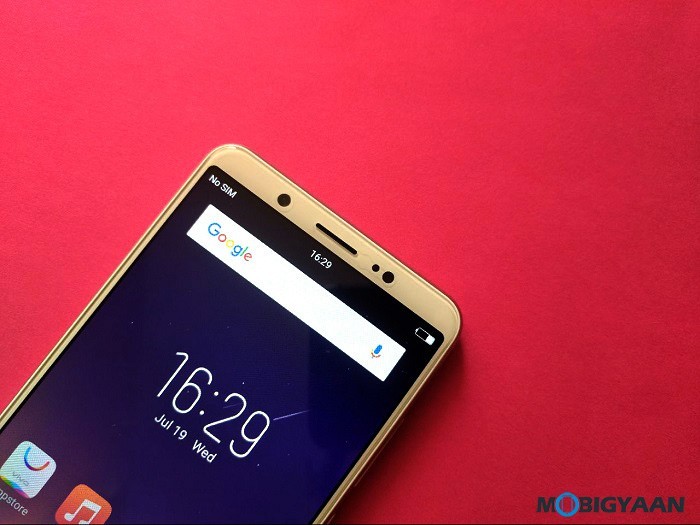
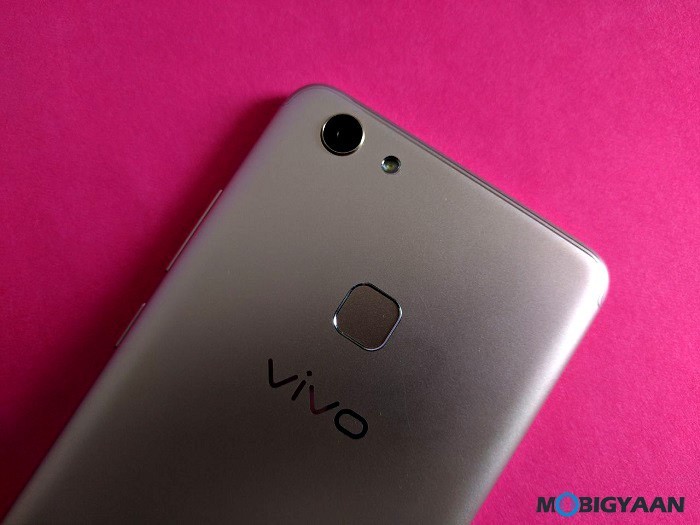
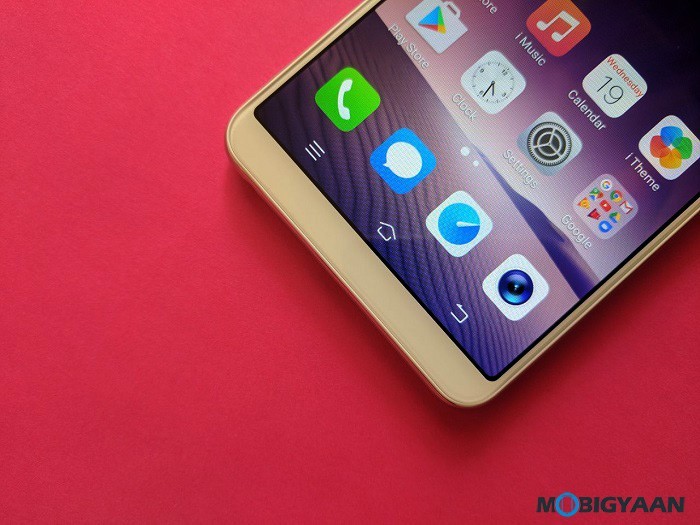
There’s no USB Type-C port at the bottom, rather Micro USB, a microphone, and a 3.5 mm headphone jack is provided, the loudspeakers sound loud and clear. On the top, it holds the second noise-canceling microphone. Like most Vivo phones, the right side holds a power button and volume keys. It supports 4G LTE network with VoLTE calling features. The single tray carries 2x nano SIM and a standalone microSD slot.

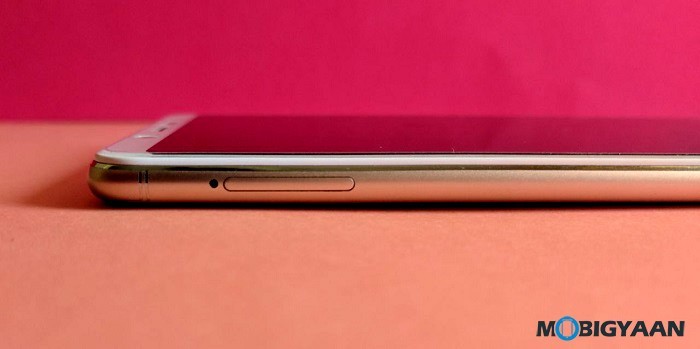
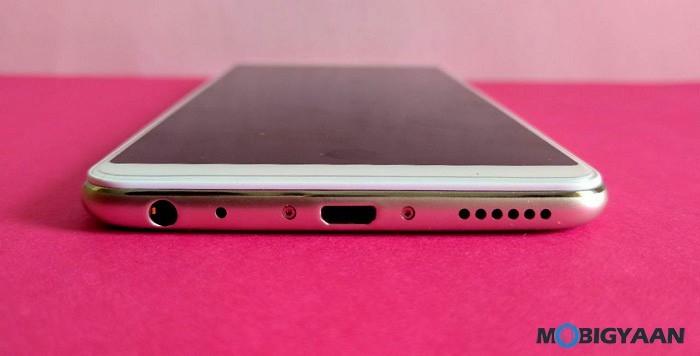
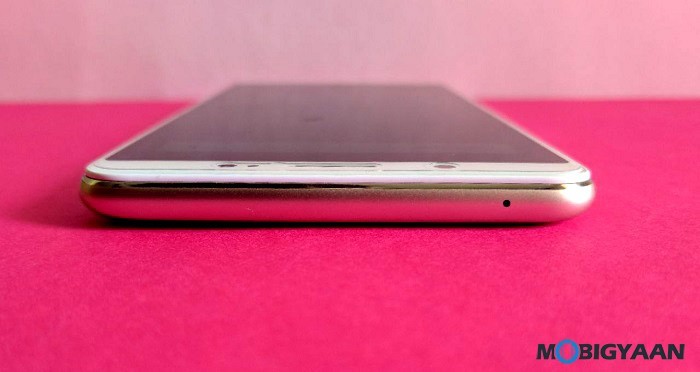
Display
Bezel-less smartphones are a new thing this year, Vivo has moved to the minimalist bezel to gain more space for the screen. Yes, Vivo V7+ has an edge-to-edge FullView display with 5.99-inch HD+ resolution (1440 x 720 pixels, 18:9 aspect ratio). For a 6-inch display, an HD+ resolution is considered lower and the text and images won’t look crisp as you see on a 1080p display. That’s a disappointment for sure, but nevertheless, even with just HD+ resolution, the display is of good quality, the brightness is high, and the bezel-less design looks amazing.
You won’t be able to find much options in the display settings, the Full screen view will scale the apps you select to the new aspect ratio i.e. 18:9. But do note that, not all apps may support the 18:9 aspect ratio, hence, you will encounter black bars on the top and the bottom. Moreover, there’s an eye protection mode that works if you want to read during the night.
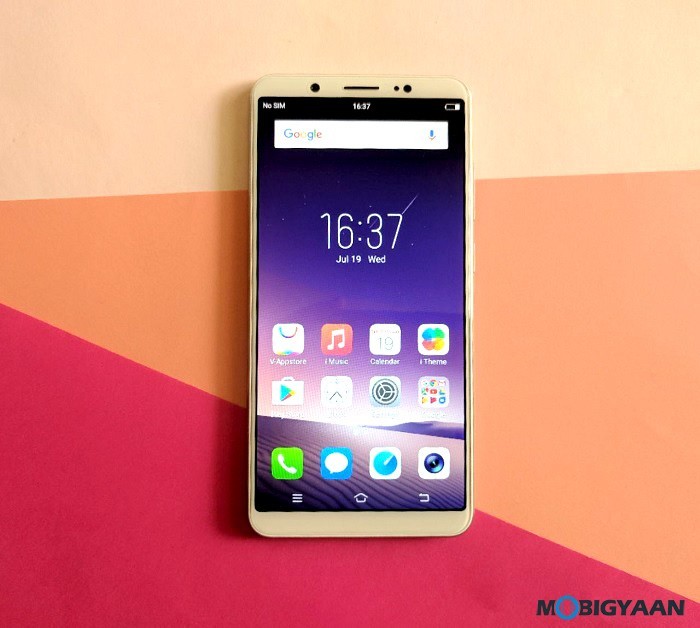
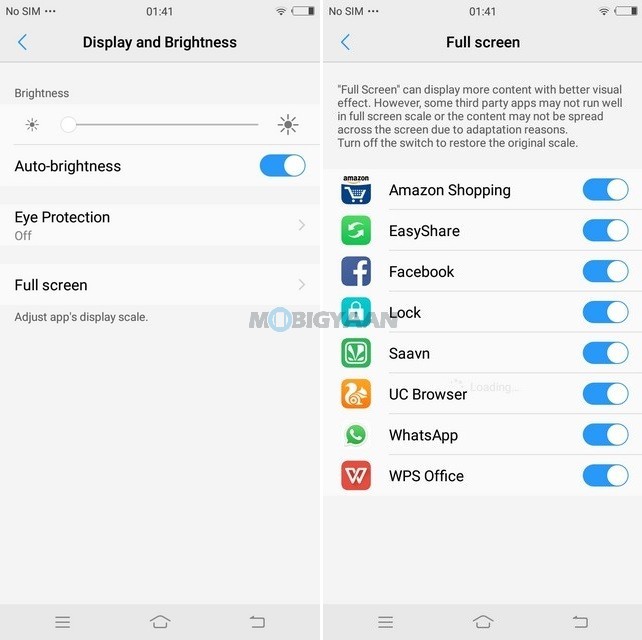
Software & User Interface
Vivo has updated the FunTouch software to the Android 7 Nougat. It’s simple, easy to use, and no-frills interface. The FunTouch OS version 3.2 is based on Android 7.1.2 with latest security patch till 1st July 2017. There are a number of features that come handy in the interface, the dual apps feature, face unlock, and split screen. Plus, the quick shortcuts can be brought by swiping from the bottom to the top.
While these are the features that we have already seen in the Vivo V5s, the face unlock is an added feature. It is quick, unlocks the face without pressing any buttons. All you have to do is pick the phone and glance at it. A cool feature that unlocks the phone, but sadly, it is not very secure.
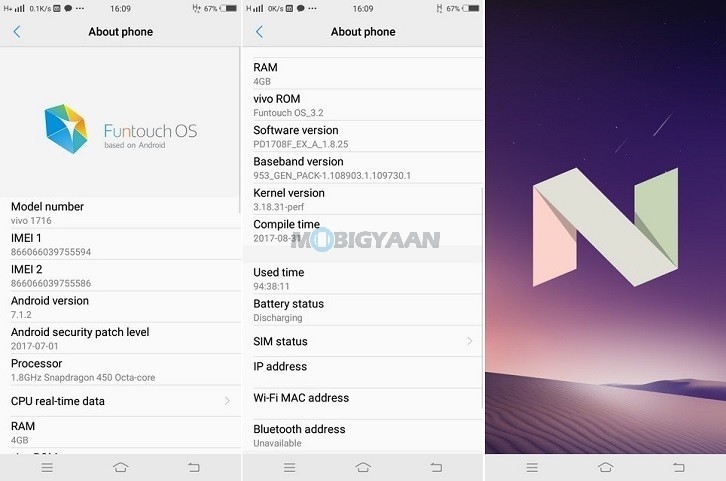
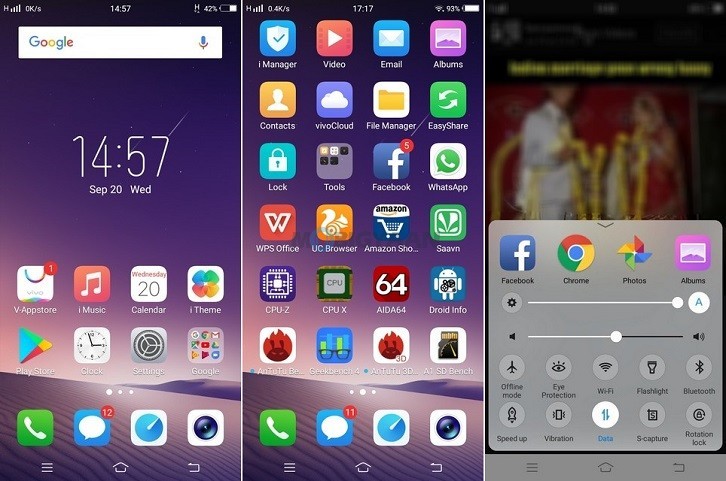
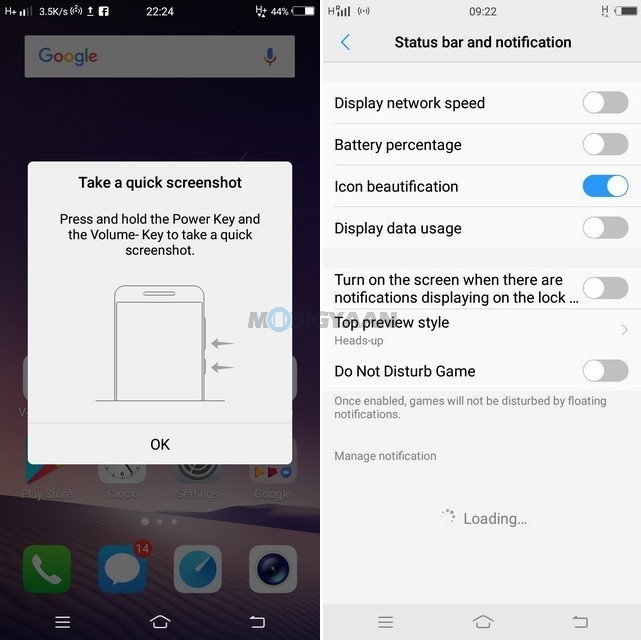
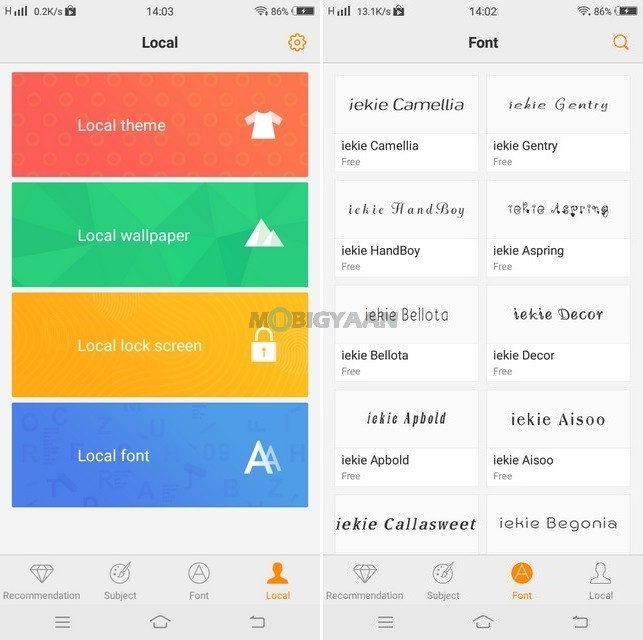
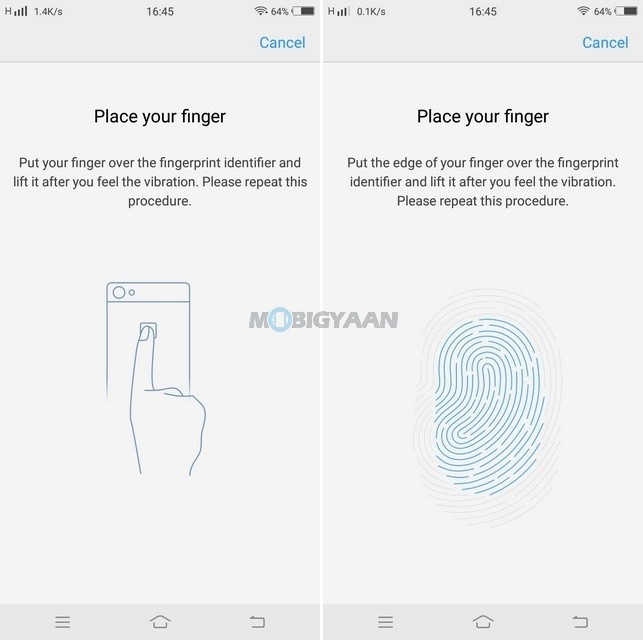
Hardware, Performance & Gaming
Vivo V7+ seems to be an entry-level smartphone in the performance department but high-end at selfie camera. It packs a mediocre hardware for its price, it’s not a performance device but it can surely give you all the basic power for daily tasks. The Snapdragon 450 is not that bad, the performance is slightly below the popular chip Snapdragon 625, it’s considerable but not if you are paying this hefty price.
Talking more about the hardware, the phone comes with 4 GB LPDDR3 RAM and 64 GB eMMC internal storage. It packs an Adreno 506 GPU for graphics accelerated tasks. This is the first smartphone to feature a Snapdragon 450 SoC which is the latest 400 series chip from Qualcomm.
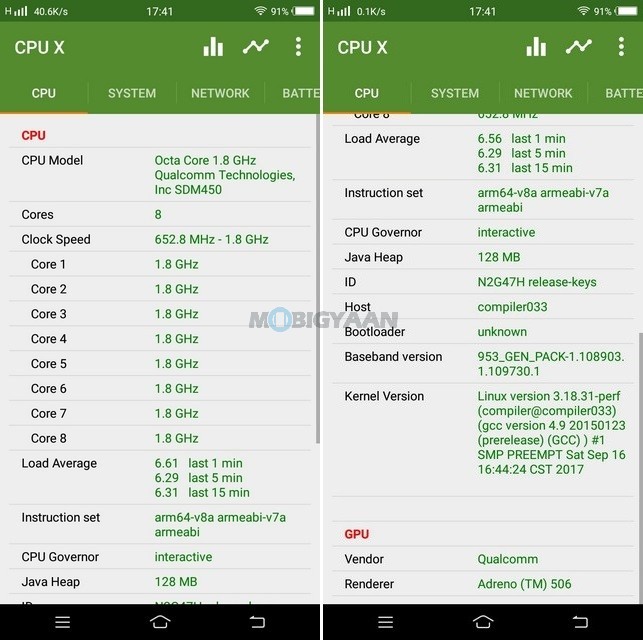
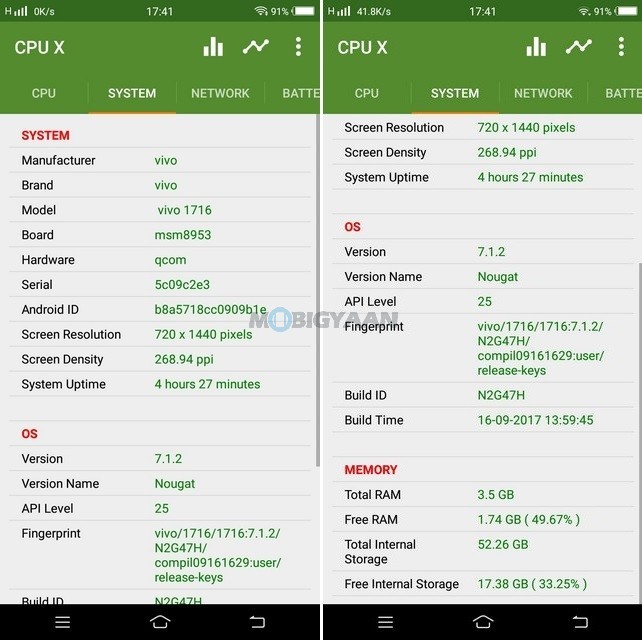
As a phone that cost as much as ₹22,000, performance users should be aware that the phone needs enough processing power to handle complex tasks or multi-tasking. The performance may not be surprising anytime soon. It struggles on the camera app, slow image processing, a little lag sometimes. If you are a selfie kind of person who just likes taking selfies, play basic games, watch videos, social media, and other basic stuff, the hardware is essential.
Here are the benchmarks that we performed on the Vivo V7+. AnTuTu scores 56,386 points, Geekbench scores 767 points (single-core CPU), 3,901 points (multi-core CPU), and 3,101 points (GPU). While the Quadrant Standard Edition gave us 23,067 points. These flashy numbers show it’s equivalent to Snapdragon 625 as well as Kirin 650. But they are similar or inferior to the phones that cost between ₹10,000 and ₹15,000.
AnTuTu Benchmark
- 56,386 points
Geekbench 4
- 767 points (single-core CPU)
- 3,901 points (multi-core CPU)
- 3,101 (GPU)
Quadrant Standard Edition
- 23,067 points
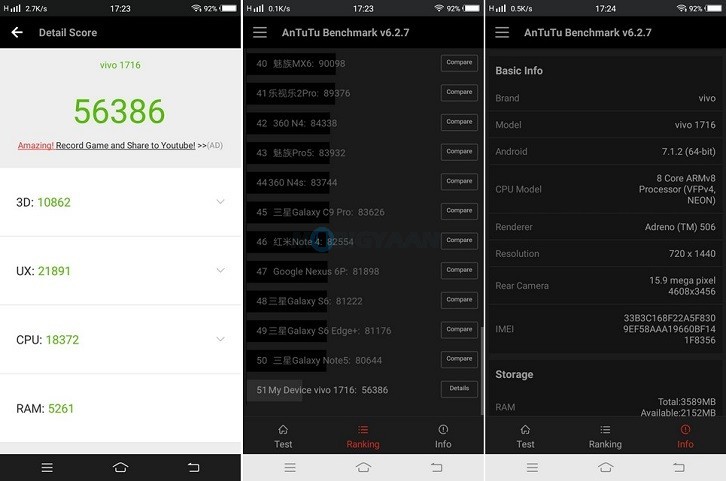
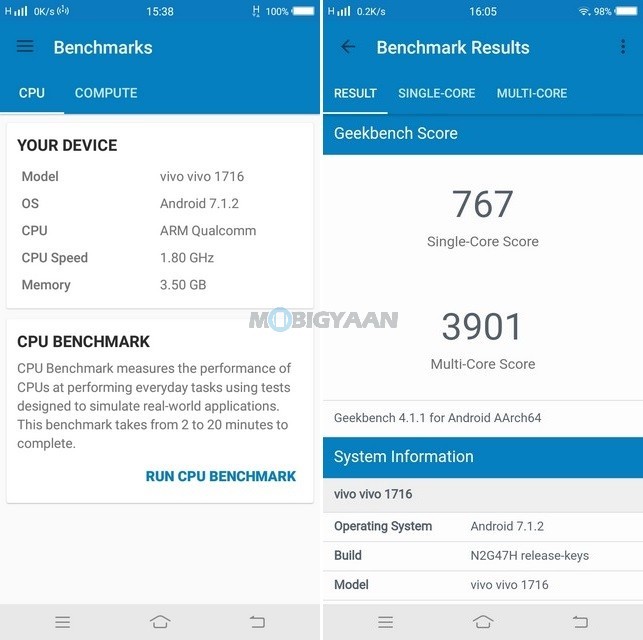
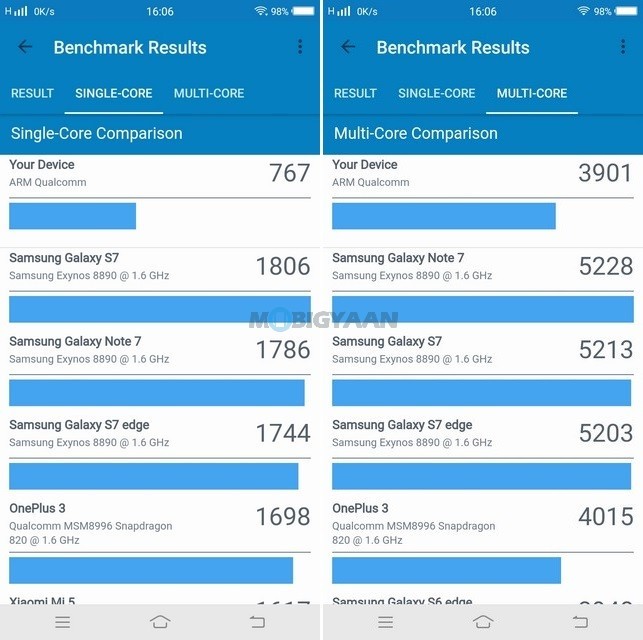
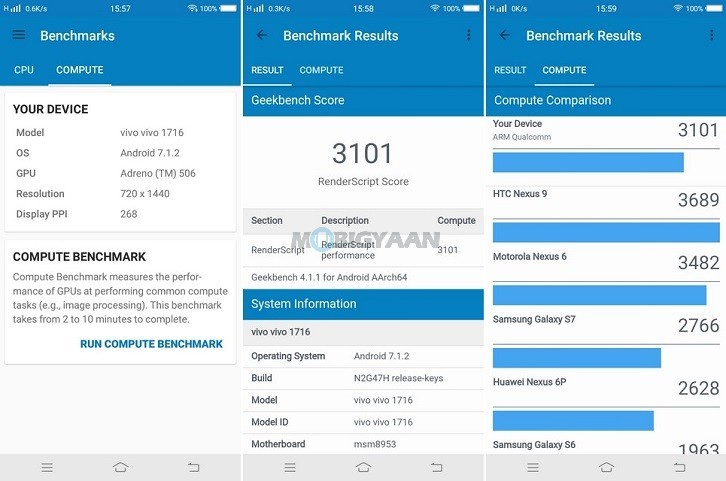
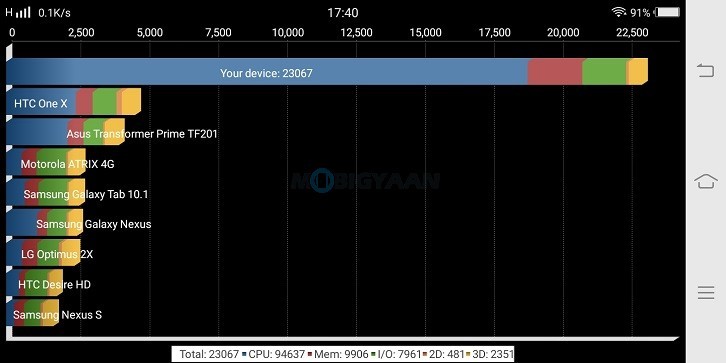
Vivo V7+ comes with Adreno 506 GPU, but Adreno 510 much more efficient for gaming. Vivo V7+ is not a good choice for gamers especially if you are into heavy gaming. It runs all the basic titles and a few moderate games without any issues. Pick a phone that suits your gaming needs. Games like Snowboard Party: World Tour, Angry Birds, and other similar 3D games are tested and runs without any major lags.
Games Tested on Vivo V7+
- Snowboard Party: World Tour
- Angry Birds
Heating? We didn’t find any temperature related issues with the phone. The phone doesn’t heat on load and remains on the cooler side. Thanks to the power-efficient system-on-chip Vivo V7+ got on-board.
Storage & RAM Performance
On the storage side, the Vivo V7+ offers 64 GB internal storage with microSD support that expands up to 256 GB. It supports USB OTG while it needs to be enabled under the ‘RAM and storage space’ settings to use it. There’s a built-in Space Management feature that clears junk files to free up internal space.
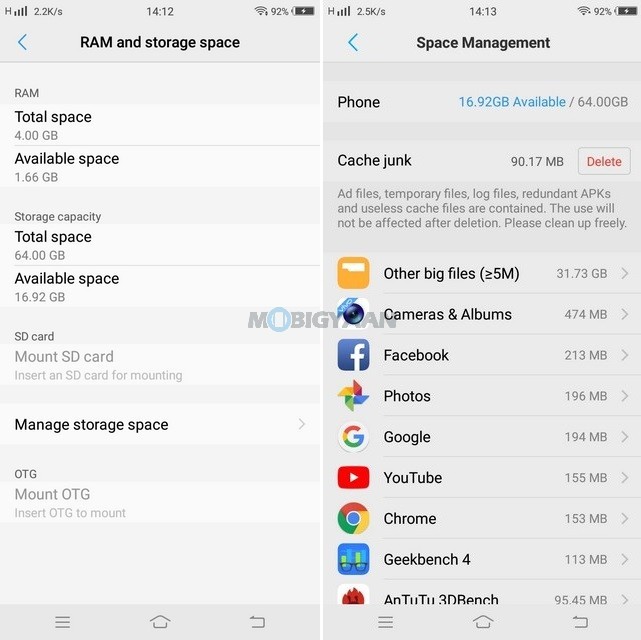
It’s an eMMC storage, so the performance of the internal storage is good even a tad higher in the midrange competition. Take a look at the benchmarks below.
A1 SD Bench
- 271.74 MB/s (Read)
- 234.89 MB/s (Write)
- 4844.67 MB/s (RAM Copy)
AndroBench
- 300.35 MB/s (Sequential Read)
- 215.30 MB/s (Sequential Write)
- 65.72 MB/s (Random Read)
- 21.42 MB/s (Random Write)
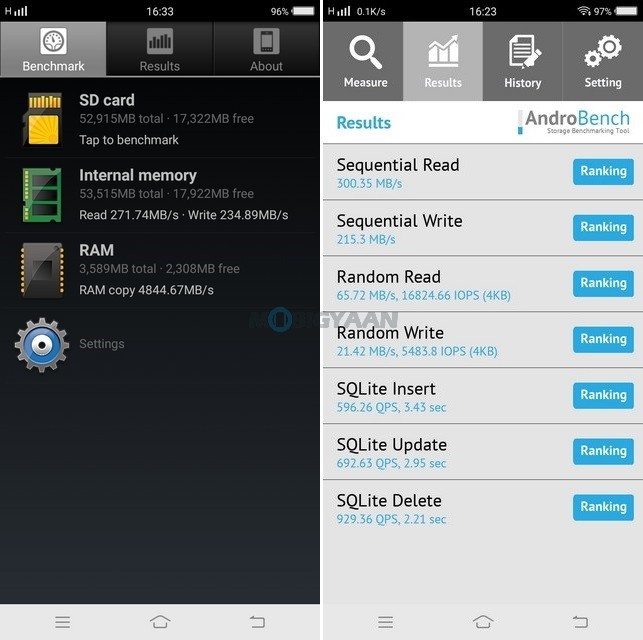
Cameras
Vivo is going crazy about how smartphones should take selfies, the company has added another selfie-focused smartphone with a 24 MP front camera, the highest megapixels ever brought in a smartphone. And what’s fascinating about this phone is the selfies look like they are captured from a professional DSLR camera, the feature is derived from the flagship Vivo V5 Plus that takes perfect selfies.
But, most notably, we didn’t see two front cameras coming, rather only one 24 MP sensor with Moonlight Glow LED Flash. The rear camera is left out in the cold, offers a lower megapixels number i.e a 16 MP sensor on the back camera, yet it too holds the power to capture bokeh photos. Cool, isn’t it?

Vivo V7+ Camera Specifications
- Camera: 16 MP
- Optical Image Stabilization (OIS): N/A
- Rear Flash: Single LED flash
- Features: Normal, Face Beauty, Group selfie, Portrait mode, LIVEOn, Watermark, Touch Capture, Voice Capture, Palm Capture, Timer, Mirrored Selfie, Geo-tagging, Tap to Focus, HDR, Color Filters, Burst Shot
- Video Recording: 1080p video @30fps
- Front Camera: 24 MP, f/2.0
- Image Sensor: OmniVision OV16880
- Video Recording: 1080p/720p/480p videos @30fps
- Front Flash: Moonlight Glow LED Flash
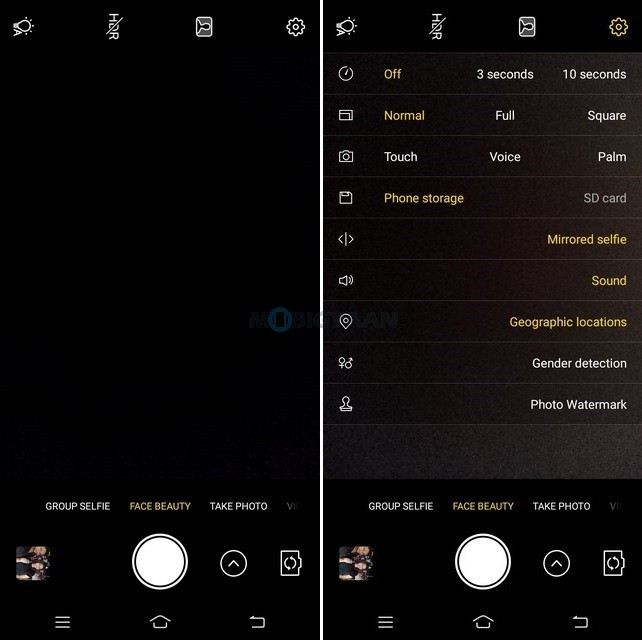
Vivo V7+ Camera Samples
Don’t be fooled by the megapixels, there’s no doubt the 24 MP camera is great for selfies, but the result may not be as appealing like a 24 MP camera, the number sounds gimmick, to be honest. It is backed up with some advanced software algorithm that generates the bokeh effects to work with one camera. But since it’s a single camera phone, Vivo didn’t provide the control over the bokeh or blur amount. The photograph you click is all you got, you cannot refocus on the object or do anything about the photo like you can do with the Vivo V5 Plus.
In a nutshell, the beauty mode is great, skin tones are brightened, the face looks beautiful, details are good, certainly not great, and the Moonlight Glow comes handy in low-light conditions. Vivo added Live photos feature that you may have seen on iPhones and other smartphones for sure. There is nothing much to complain here in the camera segment, the front camera takes out most phones (if not all) in this price range. The only thing that’s unusual is when you capture a Portrait with more than one person, the bokeh effect doesn’t seem convincing. In that case, Vivo V5 Plus turns out as a true performer.
As for the rear 16 MP camera, it too takes perfect selfies, ahem.. ahem.. not exactly selfies but photos with bokeh effects or you can say Portraits. Neither of the cameras can record 4K videos and slow-motion videos. The camera on the front side records 1080p videos while the rear camera also records 1080p videos at max. Also, the lack of OIS tells us the cameras seem to be mainstream level, not high-end if we consider everything about the cameras, not just megapixels.
Having said that, if you are the person who is into selfies, Vivo V7+ will suit you best. Even though Vivo V5 Plus turns out to be a better camera performer, Vivo V7+ is slightly cheaper than the latter. But I would pick Vivo V5 Plus any day.
Battery Runtime
Vivo provides a 3,225 mAh battery and that’s quite average nowadays, smartphones with half the price offer more capacity. Vivo V7+ is not the best in battery backup but it does offer a decent runtime for average usage.
The battery runs a day and a little more than that on average use. We ran the basic stuff on a phone that people do on a daily driver basis, things like calls, 4G data, Wi-Fi Hotspot, YouTube, Audio streaming, video playback, camera, gallery, and a little gaming. The heavy usage may not stretch the battery life to the full day.
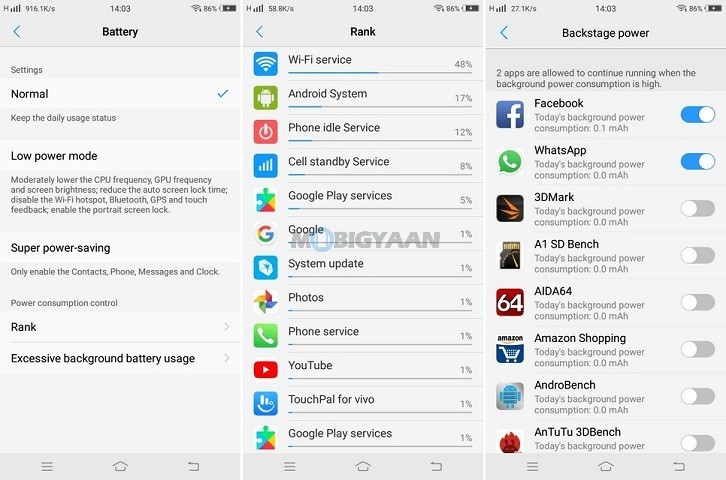
Vivo V7+ Battery Test Results
[table id=115 responsive=flip /]
Verdict
And we come to our final verdict, in a nutshell, the phone is the best when it comes to selfies, hands down. Moreover, it’s gorgeous edge-to-edge display, fast fingerprint scanner, face-unlock feature, easy to use interface, and dual apps feature are those things to like about the phone.
Although Vivo offers a single front camera, Snapdragon 450, and an HD+ display and asking a price of ₹21,990, we can say the Vivo V5 Plus emerges better in terms of overall value (priced ₹22,990). More selfie phones have already entered the selfie market, Oppo F3 Plus, ASUS ZenFone 4 Selfie Pro, Honor 9i, yet Vivo leverages the selfie camera business as of now with the best selfie shots.
Consider this phone if you are a selfie lover and want a good looking phone with a big display. Performance users should opt a different phone.
Rivals
- Vivo V5 Plus – ₹22,990
- Honor 9i – 17,999
Strength
- Large 6-inch 18:9 FullView Display
- Good Display Quality
- 24 MP Front Camera Snaps Great Selfies
- Loud & Clear Audio
- Fast Face Unlock & Fingerprint Scanner
- Standalone MicroSD Support
Weakness
- HD+ Resolution Inferior For 6-inch Size
- No 4K Video Recording
- Substandard To Predecessor (Vivo V5 Plus)

















